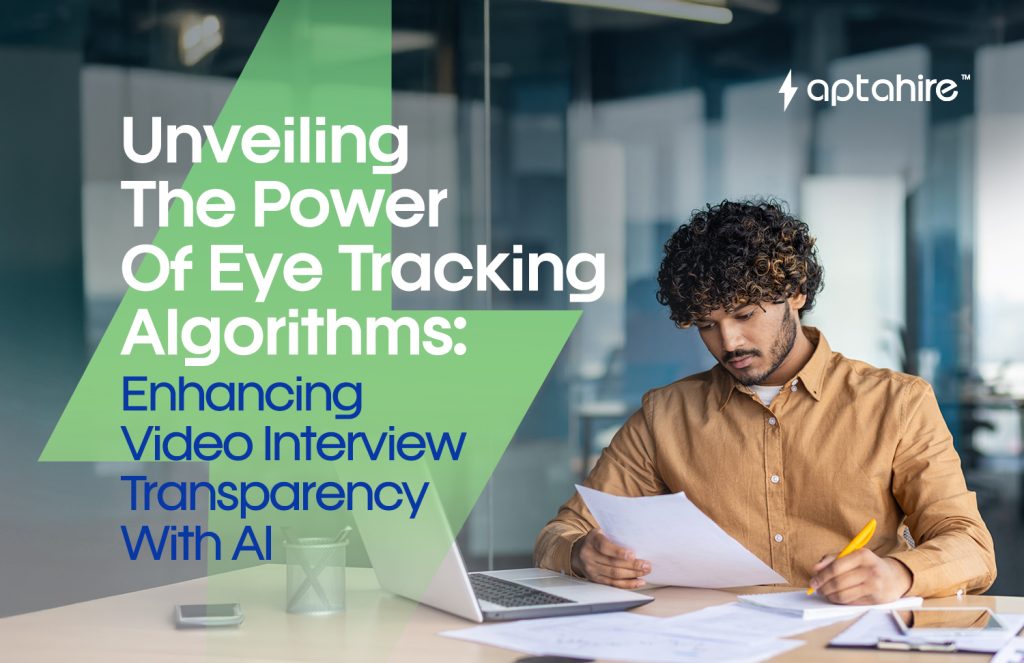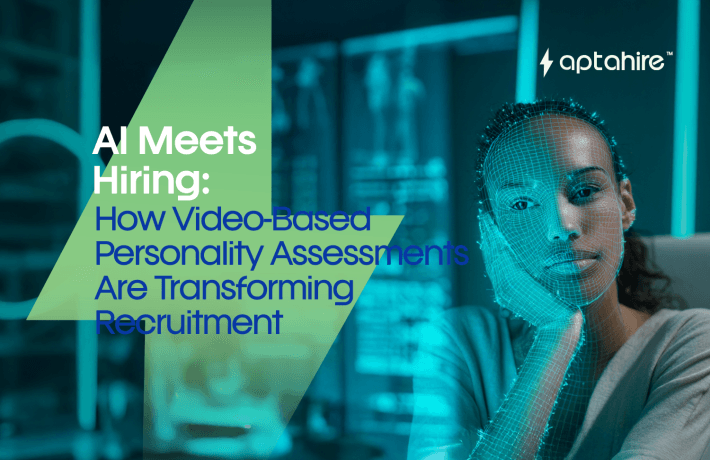Unveiling the Power of Eye-Tracking Algorithms: Enhancing Video Interview Transparency with AI

In today’s hyper-connected world, remote hiring isn’t a futuristic concept, it’s our present reality. Companies are scaling rapidly, tapping into global talent pools, and conducting interviews via screens rather than across the table. While this digital transformation brings flexibility and scalability, it also opens a Pandora’s box of new challenges:
- Is the person on the screen truly who they claim to be?
- Are they answering honestly, or being prompted?
- Are they multitasking, searching for answers mid-interview?
These questions are becoming increasingly common among recruiters and HR professionals. And traditional video tools offer little to no help. That’s where AI-powered eye-tracking algorithms come into play, offering a revolutionary approach to human observation, one blink at a time.
Let’s take a deep dive into how eye-tracking algorithms are enhancing video interview transparency, upholding hiring integrity, and pushing the limits of fair, ethical AI hiring.
What Is Eye-Tracking in the Context of AI Hiring?
Eye-tracking is a biometric technology that captures the precise movements of the eyes, including where a person is looking, how long they focus on a specific point, and how their eyes behave under cognitive or emotional stress.
In AI hiring, eye-tracking algorithms are trained to monitor and interpret these visual behaviors in real time during a virtual interview. This data is then used to assess engagement, authenticity, focus, honesty, and even stress levels.
But we’re not just talking about tracking someone’s gaze. We’re talking about decoding behavioral psychology through advanced machine learning. It’s not surveillance, it’s insight.
The Neuroscience Behind Eye Movements
Our eyes are more than just sensory organs, they are mirrors of the mind. Decades of psychological and neuroscience research confirm that eye movements are involuntary indicators of thought processes. For instance:
- Frequent blinking is associated with anxiety or high cognitive load.
- Looking up and to the right might signal imaginative or fabricated thinking.
- Prolonged downward glances often indicate that someone is reading or recalling.
- Side glances could mean distraction or attention to external help.
AI hiring platforms leverage this science to draw meaningful behavioral inferences, in milliseconds.
How Eye-Tracking Algorithms Work in AI Hiring Platforms
Let’s break it down step-by-step:
1. Facial Detection & Landmark Mapping
Using convolutional neural networks (CNNs), the algorithm identifies facial features including pupils, eyelids, and eye corners. This creates a digital map of the candidate’s face.
2. Gaze Estimation
Based on the eye’s orientation, the AI determines where the candidate is looking:
- At the screen (centered gaze)
- At a second monitor
- Downward (potential script)
- Sideways (possible assistance)
It considers angle, velocity, and consistency of eye movement across frames.
3. Fixation and Saccade Analysis
- Fixation refers to the eyes staying in one place. Long fixations downward suggest reading.
- Saccades are rapid eye jumps. Abnormal saccades may indicate tab switching or external scanning.
4. Temporal Behavior Mapping
The AI compares eye movement patterns across the interview timeline. This helps detect repetitive behaviors, like:
- Repeated checking of notes
- Multiple off-screen glances in specific moments (e.g., during technical questions)
5. Classification & Scoring
The system classifies behavior into risk categories:
- Focused
- Distracted/Unnatural
- Assistance Detected
It then generates a confidence score and visual heatmap for recruiter review.
What Eye-Tracking Can Actually Reveal
Script Reading Detection
If a candidate is frequently looking down, especially during complex responses, the system flags it as probable reading behavior.
Real-Time Tab Switching
Left-right rapid movements in gaze signal attempts to search for answers online or switch between applications.
Presence of Off-Camera Assistance
Consistent eye direction toward a fixed spot (like a person out of frame) triggers a behavioral anomaly.
Cognitive Overload
High blink rate and pupil dilation suggest stress or excessive mental strain, possibly because they’re lying or unprepared.
Suspicious Activity Alerts
Combined with motion detection, eye-tracking can even reveal:
- Background activity
- Candidate leaving screen
- Use of secondary devices
Improving Interview Fairness and Reducing Bias
Ironically, while it may feel like eye-tracking “judges” candidates, it actually does the opposite, it levels the playing field.
Here’s how:
- Objective Data: It eliminates gut-feel decisions by giving recruiters quantifiable data on behavior.
- Bias-Free Analysis: Algorithms don’t consider age, gender, or appearance. They track behavior, not identity.
- Supports Genuine Candidates: Those who are honest, focused, and prepared stand out naturally.
Real-World Results: Adoption and Accuracy
- 92% of employers using Aptahire’s eye-tracking system reported more confidence in hiring decisions.
- Over 43% of rejected candidates were found to have suspicious gaze behavior, which was later confirmed during background checks.
- Eye-tracking, when combined with audio and emotion analysis, improved detection accuracy by 63%, according to a 2023 study in the Journal of Behavioral Biometrics.
How Eye-Tracking Complements Other AI Tools
Eye-tracking doesn’t work in isolation. Here’s how it forms a part of a multi-dimensional fraud detection system:
| AI Tool | What It Detects | How It Syncs with Eye-Tracking |
| Facial Emotion Recognition | Microexpressions and emotional congruence | Validates honesty through eye-emotion sync |
| Voice Stress Analysis | Tone, pitch, hesitation | Detects nervousness alongside blinking rate |
| Keystroke Biometrics | Typing rhythm and consistency | Useful in asynchronous tests with visual monitoring |
| Deepfake Detection | Manipulated audio/video | Ensures the eyes belong to the actual person interviewed |
This layered AI approach ensures you’re not relying on just one signal, but a full behavioral profile.
Challenges & Ethical Considerations
Eye-tracking isn’t without challenges:
- Lighting and Camera Quality: Poor resolution or lighting can reduce accuracy.
- False Positives: A nervous but honest candidate might show gaze anomalies.
- Privacy Concerns: Candidates must consent and be informed about how data is used.
Ethically built platforms disclose data collection, anonymize sensitive inputs, and provide opt-outs for candidates with eye-related medical conditions or neurodiversity.
What the Future Holds for Eye-Tracking in Hiring
The next generation of eye-tracking could include:
- VR Interviews with 360° gaze mapping
- Adaptive AI Interviews that adjust questions based on gaze confusion
- Behavioral Trend Prediction to match learning styles and roles
- Bias Correction Loops where algorithms learn from recruiter feedback and evolve
We’re heading toward context-aware hiring, where a candidate’s behavior is interpreted holistically, fairly, and without judgment.
Key Takeaways
- Eye-tracking algorithms monitor visual behavior to ensure candidate authenticity during virtual interviews.
- They detect cheating, distraction, dishonesty, and cognitive overload.
- Combined with voice, facial, and keystroke analytics, they form a robust integrity-check framework.
- Transparent communication and privacy protection are key to ethical use.
- The future of hiring will not just evaluate what candidates say, but how they behave.
Conclusion
In a world where anyone can appear professional through a webcam, eye-tracking helps us look beyond the screen. It restores a sense of presence, trust, and transparency, bridging the gap between technology and human intuition.
Whether you’re a recruiter striving for cleaner hires or a job seeker committed to honest representation, eye-tracking ensures the interview remains what it was always meant to be, a fair conversation.
Ready to bring more clarity to your hiring pipeline?
Platforms like Aptahire offer intelligent, eye-tracking-enhanced interviews that make every pixel of your hiring process count.
FAQs
1. What is eye-tracking in the context of AI interviews?
Eye-tracking refers to the use of AI algorithms that monitor and analyze a candidate’s eye movements during a video interview to assess focus, behavior, and authenticity. It tracks gaze direction, blink rates, fixation points, and pupil movement to detect irregular patterns or signs of external help.
2. How accurate are eye-tracking algorithms in detecting dishonesty or distraction?
While not 100% foolproof, advanced AI models using eye-tracking have shown up to 85–90% accuracy in flagging potential distractions or suspicious behaviors when combined with other modalities like facial expression and voice analysis.
3. Can eye-tracking differentiate between natural nervousness and actual cheating?
Yes, to an extent. The algorithm is trained to look for patterns over time rather than isolated behaviors. While a few nervous glances or blinks are normal, consistent off-screen focus or repetitive gaze shifts may indicate external influence or multitasking.
4. What kind of behaviors can eye-tracking detect in a virtual interview?
Eye-tracking can detect:
- Reading from scripts
- Frequent tab switching
- Presence of someone else guiding the candidate
- Lack of attention or disengagement
- Emotional stress or cognitive overload
5. Will I be penalized if I naturally look away or blink often?
No. The system doesn’t judge based on isolated incidents. It evaluates behavioral trends over the duration of the interview. Natural eye movements are expected and factored into the scoring model.
6. Is eye-tracking technology intrusive or a violation of privacy?
Not if implemented ethically. Candidates are always informed beforehand and must consent to the use of such technology. Reputable platforms also ensure all data is anonymized, securely stored, and not used beyond the hiring purpose.
7. Can a poor camera or lighting setup affect the performance of eye-tracking?
Yes. Low-resolution webcams or bad lighting can reduce tracking accuracy. Most platforms recommend using a well-lit room, a stable webcam, and positioning yourself centered in the frame for best results.
8. How is eye-tracking different from facial recognition or screen monitoring?
- Facial recognition identifies the person.
- Screen monitoring captures screen activity.
- Eye-tracking analyzes how and where you look to detect attention, engagement, and possible dishonest behavior.
9. Can I disable eye-tracking during an interview if I’m uncomfortable?
Some platforms allow you to opt out, especially if you have a medical condition (like a tic disorder or eye injury) that affects gaze. It’s best to inform the recruiter in advance so alternatives can be provided.
10. Does eye-tracking introduce bias or discrimination into the hiring process?
When used responsibly, eye-tracking reduces human bias by providing objective behavioral insights. It doesn’t consider race, gender, or appearance, only eye movement and engagement patterns.
11. How do recruiters use eye-tracking data after an interview?
Recruiters typically receive a behavioral integrity report that includes focus heatmaps, distraction alerts, and engagement scores. These insights are used alongside interview performance, not as the sole decision factor.
12. Can eye-tracking be fooled by trained behavior or rehearsed movements?
It’s extremely difficult to consistently fake natural eye behavior. AI systems detect micro-patterns and timing irregularities that are hard to replicate manually, making it a reliable tool even against rehearsed cheating attempts.



